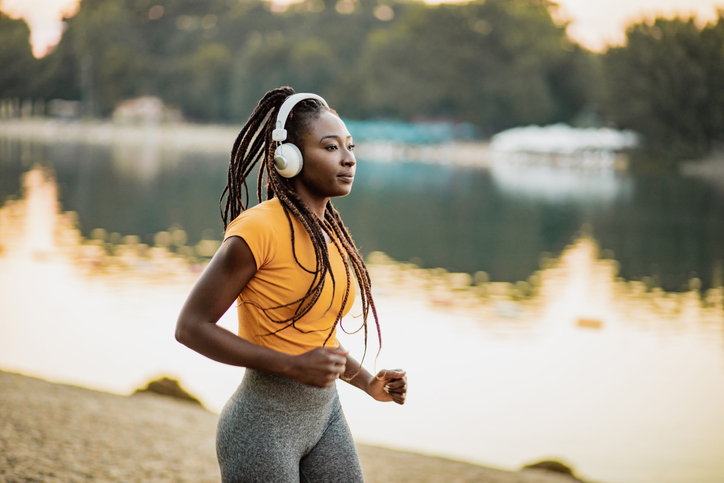
Source: blackCAT / Getty
With Ms. Rona raging on, there’s no telling when it will be safe to resume the activities of our normal lives—especially those that required us to interact with a lot of people or touch things other people have already touched.
Y’all already know I’m talking about the gym. So for the health enthusiasts among us, that’s relegated us to our homes.
We don our most comfortable, trusted leggings, stand in front of a mirror or screen, lift, stretch, dance, and sweat.
Afterward, with those endorphins coursing through your system you feel accomplished and powerful. Maybe even invincible.
But if you don’t take those wet leggings off, you could be brought to your knees with a vaginal infection.
Recently, we spoke to OB/GYN Dr. Lakeisha Richardson about how to keep your vagina happy and healthy during and after your workouts.
See what she had to say below.
Before we talk about what you shouldn’t be doing, can you tell us about the benefits working out can provide to your vaginal health?
Just being active and being healthy benefits women’s overall health and particular exercises thigh or kegel exercises and squats, that helps preserve the vaginal tissue and the tone of the vaginal tissue.
How important is it to change your clothes after a workout?
I definitely recommend that whenever you’re working out you get out of your wet clothes as soon as possible. And then also, if possible, more and more athletic wear companies are making tights or shorts that are moisture-wicking, meaning they pull the sweat off of you. So I recommend, if you can, purchasing tights or wearing shorts that are moisture-wicking. They help keep the vaginal area drier. You can work out in those type of tights without underwear.
More and more women because tights are so fashionable now, we like to wear them to workout and then even keep them on to run to the grocery store. But we really recommend getting out of those wet clothes, even if you put a fresh new pair of leggings on. That’s fine but get out of wet tights as soon as possible.
Why is it so important to keep moisture away from the vaginal area?
Moisture increases the risk of infection, yeast or bacterial infections. Moisture changes the pH of the vagina and you’re more likely to get bacterial vaginosis (BV) because your vagina is sitting in that moist, dark area and that’s a great breeding environment for bacteria.
If you are the type of woman who wants to wear underwear during workouts, what type of underwear should we be wearing?
I would definitely recommend a cotton, breathable panty. And some athletic brands make underwear for working out.
Is it important that women are wearing cotton underwear during the day as well?
Day to day, they don’t have to be cotton. But I recommend that the lining, the middle portion of the panty be cotton. But the rest of the panty can be any material.
Are there certain workouts that are more difficult for the vagina or will make you more susceptible to infections afterward?
Not more susceptible to infection but I think women who cycle will tell you that they have an increase in irritation or pain if they don’t wear the appropriate underwear or biking shorts while they’re riding a bike. But otherwise, there’s not a particular exercise that is worse for the vaginal area.
Are vaginal odors after workouts common?
Yes, especially if you already have a bacterial infection. If you have a mild BV, if you work out that odor may be more pronounced.
If you are noticing an odor, don’t self-treat. See your doctor as soon as possible.
Are there any long term effects that can come having repeated vaginal infections, either yeast or bv?
Not from yeast or bacterial. But other infections that go undiagnosed do increase the risk of pelvic inflammatory disease (PID) and subsequently cause tubal disease, scarring and can lead to infertility.
Women who have untreated BV can increase their risk of having chronic bv which requires a six-month treatment program.
Are there chronic yeast infections as well?
Yes, some women do have chronic yeast infections. And, of course, diabetics are more prone to recurrent yeast infections as well.
And what’s the treatment like for that?
There is a special culture you can do to look for sensitivities to yeast because there actually is more than one type of yeast. We try to identify the actual type and see if it’s resistant to the typical treatment.
Normally, we use Diflucan or an over-the-counter cream but sometimes it can be resistant. Most of the time when people take a Diflucan, they’ll just do one. It’s designed to be a one dose therapy. But some women may have to take one tablet once a week or four weeks depending on the severity of the infection.
Are there things women can do in terms of diet to help treat vaginal infections? I know for yeast infections, sugar can be a problem.
Yes, sugar is always a problem for yeast. Most of the time, we’ll tell women if they don’t want to take Diflucan, we recommend yogurt for yeast and then there are also boric acid suppositories that are not technically an antibiotic that you can use as you need it for BV or mild discharge. And we also recommend a probiotic. RepHresh makes a probiotic that is great for women’s vaginal health.
What are some things women should generally avoid when it comes to vaginal health, whether you’re working out or not?
We’re definitely against douching. OB/GYNs do not recommend douching at all. However, if they want to use an external wash like Vagisil that’s perfectly safe. RepHresh also makes a vaginal gel for vaginal order that women can use after workouts that is non-hormonal and safe.

Source: Courtesy of Dr. Lakeisha Richardson / Courtesy of Dr. Lakeisha Richardson
Dr. Lakeisha Richardson, MD is a Obstetrics & Gynecology Specialist in Greenville, MS.









